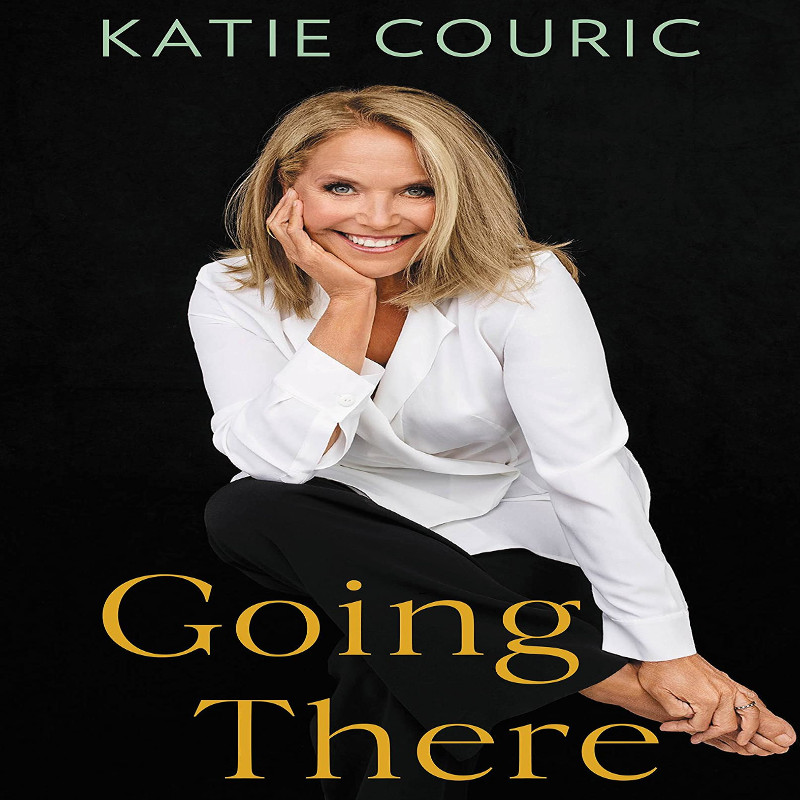Review by Beth Ryan Aitken
I love a good memoir. A chance to glimpse into the world of someone who has faced challenges or overcome obstacles. I prefer a memoir to an autobiography (or a biography) because a memoir is often more conversational and personal. (That is how the two genres are distinguished; memoirs are more of a personal recollection.) Katie Couric’s new memoir Going There intrigued me, since I often listen to her podcasts and follow her daily email newsletter.
Couric brings to this book her signature breezy style, often self-depreciating, very candid and definitely straightforward. But don’t let her bright smile and cheerful demeanour fool you, Katie has been through plenty of difficulties and tragedy. She is just a few years younger than me, so I was drawn into her descriptions of growing up in the ’50s and ’60s suburban America. And as her career in news and broadcast journalism grew, the accounts of both newsworthy events and people were all familiar to me. Her encounters with the movers and shakers of society are highlighted throughout the book. For example, recalling a congratulatory note on her recently announced pregnancy, from General ”Stormin’ Norman” Schwazkopf, suggesting that “Norman would be a good name for the baby. And if it’s a girl, Stormy Norma! ”
This memoir offers up a very good balance between her family life and professional life. Like all working mothers, she struggled with childcare and priorities. Unlike most, however, she had a remarkable income to cover the cost of nannies, private schools, and vacations. She was always aware of the example she was setting, not only for her contemporaries, but also the generation to come.
Couric lost her first husband Jay to colon cancer at age 42. It was unimaginably difficult. She feels his absence very strongly, calling to mind what he might have said or felt in certain situations, what advice he may have given their daughters, sharing her sadness at the life events he has missed. She later became a crusader for cancer prevention and early detection, even having a colonoscopy live on-air on the TODAY show. The foundation she co-founded (Stand Up 2 Cancer) continues to raise millions for cancer research.
A significant number of reviewers have focused on her relationship with Matt Lauer, her co-host for many years on the TODAY show. In 2017, Lauer was fired abruptly from the show for sexual misconduct and accusations of assault. By then, Couric had left the show and moved on to become the first female solo news anchor of an evening newscast at CBS. But she had been Lauer’s professional colleague for more than a decade. Couric devotes several chapters to describe what she knew about Lauer’s behaviour, what rumours she had heard, how she felt and dealt with the news, and the fallout. She seems honest and vulnerable in her account.
The book is chronological, lining up one historical event after another through her accounts of encounters and interviews. She is consistent in her authenticity, and it is interesting to read about how she thinks she might handle a certain interview differently today than she did at the time. When Ruth Bader Ginsberg made a very questionable comment in an interview, Couric struggled with whether to include it in the televised report and risk damaging Bader’s reputation. She doesn’t cut herself much slack, freely admitting where she goofed up.
By the conclusion of the book, she is happily married again, her daughters are adults, and along with husband John Molner, she has founded a media company producing podcasts, a daily newsletter, videos, and various social media content. She says it is a new lease on her professional life.
I found the many different themes of the book riveting. Her experiences of being a young, admittedly perky woman in the male-dominated news business, her determination to put journalism first, her awareness of her own white privilege and opportunity while trying to pave the way for a younger generation of women in the business are all evident throughout the book. Also the insider’s view of the nitty gritty workings of major news shows, the fierce competition to “get” the important interview, the lack of cooperation between colleagues, were really eye opening. Her writing style is engaging and the book moves along quickly. She is still doing the kind of work she excels at and this book is an amazing look at the past 40 years of broadcast journalism.












